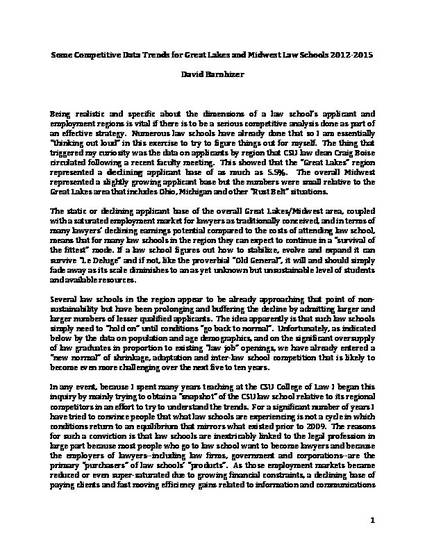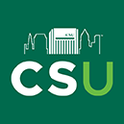
Unpublished Paper
Some Competitive Data Trends for Great Lakes and Midwest Law Schools 2012-2015
Unpublished Paper
(2016)
Abstract
As can be seen by looking at the regional law school data presented below for the primary competitive markets within which the law schools in the Great Lakes/Midwest region operate the situation is made more challenging by the addition of several critical factors. They include:
1. The Great Lakes/Midwest region is economically depressed and while it may experience a partial recovery it nonetheless will fall short of recreating the base of manufacturing activity that produced a strong upwardly mobile middle class of the kind that sustains high-level educational activity.
2. The region’s populations are static, aging or declining with the result that the applicant pool for law schools in the geographic area is falling,
3. The region’s lawyer job markets are saturated to the point that there are not a significant number of new jobs being created and the replacement market that depends on the deaths or retirement of lawyers currently in practice is slow moving.
4. Public budgets for local and state governments in the Great Lakes/Midwest region are under significant stress with the result that those institutions represent a largely static or declining employment market for lawyers.
5. A significant number of the region’s “top” law jobs will be “cherry-picked” by graduates of law schools such as Harvard, Yale, Michigan, Ohio State and a few others.
6. The systemic pressures on law schools trying to survive in the depressed applicant market and convince those to whom they extend offers to attend the law school will create a sort of financial “death spiral” in which law schools rely on greatly expanded financial aid packages in an effort to “buy” students, along with staff and faculty reductions since few law schools have a significant endowment “cushion” to buffer the declining financial situation. This creates an incentive to admit marginal students at the lower end of the scale who pay full tuition in order to fund the subsidies and scholarships given to more highly qualified applicants.
These factors mean that for virtually all the law schools located in the competitive region represented by the Great Lakes/Midwest venue the competitive situation is considerably more challenging than in most of the US. This is because a further drying up of the lawyer employment market guarantees a continuing and significant drop in the applicant market. As we can see from the data set out below, the decline in applicants is not only in the absolute numbers but the quality of applicants as measured by performance on the LSAT. Although there are important skills of the lawyer in addition to the kinds of “analytical firepower” reflected in the LSAT it is undeniable that the ability to think critically, analyze issues and facts in depth and perform at high verbal levels are among the most central abilities of effective lawyers.
We can begin by looking at the population demographics of the area from which a law school draws its students. In the Great Lakes and Midwest region from which most of the law schools in this analysis draw their applicants, enroll students and attract employers of their graduates the population demographics are static or declining, not only in terms of absolute population numbers but in relation to the primary age ranges from which students can be expected to enroll in a law school. Projections for Ohio (and Michigan) indicate that potential applicants in the target age ranges are steadily declining, creating a progressively smaller applicant pool for law schools.
As if it isn’t enough to have the demographics on which law schools depend for their applicants and matriculating students sliding downward, most of the law schools in the region are relatively “local”. This means they can expect many of the more highly proficient applicants to law schools to be attracted to more “national” law schools with more sought after “brands” that increase graduates’ employment prospects. For Great Lakes/Midwest law schools located in that geographic region the best “brands” are the University of Michigan, Chicago, Northwestern, Notre Dame and Ohio State. For many of the most highly credentialed applicants the law schools with “national” brands such as Harvard, Yale, Columbia, NYU, Stanford, Georgetown, Duke or Virginia will increasingly siphon away students who previously might have enrolled at one of the “local” or “regional” law schools.
This clear trend means that many of the “lesser” law schools in the Great Lakes/Midwest region are largely left “out in the cold” in relation to being able to attract significant cohorts of well-qualified applicants and students. Most of the Great Lakes/Midwest law schools will shrink another 10% to 25%. They will be faced with increasingly dire financial conditions as revenues fall and funds are directed toward scholarships in an effort to “buy” applicants. Parent universities are also under significant financial pressure and the demographic changes described below mean that universities will have to make hard choices about resource allocation in an era where law schools are no longer “cash cows” generating surplus revenue for the overall university.
Keywords
- Key Words: legal education,
- law school applicants,
- declining enrollments,
- LSAT scores,
- legal profession,
- lawyers,
- declining legal employment,
- population demographics,
- demographics of legal education,
- surplus of law graduates,
- too many lawyers
Disciplines
Publication Date
2016
Citation Information
David Barnhizer. "Some Competitive Data Trends for Great Lakes and Midwest Law Schools 2012-2015" Unpublished Paper (2016) Available at: http://works.bepress.com/david_barnhizer/111/
